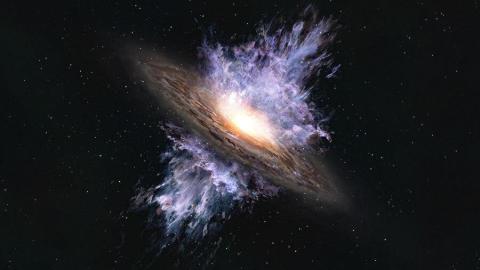Galactic wind from early universe detected

Credit: ALMA (ESO/NAOJ/NRAO)
- A new study finds the oldest galactic wind yet detected, from 13.1 billion years ago.
- The research confirms the theory that black holes and galaxies evolve together.
- The galactic wind was spotted using the Atacama Large Millimeter/submillimeter Array in Chile.
An enormously powerful galactic wind generated by a supermassive black hole 13.1 billions years ago has been discovered by researchers. The scientists used the Atacama Large Millimeter/submillimeter Array (ALMA) in Chile, which combines 66 radio telescopes, to make the find. The results are published in the Astrophysical Journal.
This is the earliest example of this type of wind yet spotted that underscores the role of black holes in the formation of galaxies. Research has shown that galactic winds affect redistribution of metals around the galaxy and impact start formation.
Black holes and galaxies evolve together
In previous studies, scientists have noticed an unexpected proportional relationship between the mass of a supermassive black hole at the center of a large galaxy, which can grow up to billions of times more massive than the sun, and the mass of the galaxy’s central area (known as a “bulge”). The proportionality of the masses is especially unusual considering that galaxies and black holes are so different in size, with the bulge generally being orders of magnitude larger. This led the researchers to conclude that galaxies and black holes developed together through coevolution, which involved some physical interaction courtesy of the galactic wind.
As ALMA’s press release explains, a galactic wind starts coming into existence when a supermassive black hole gobbles up giant quantities of matter. It is then moved at such a high speed by the black hole’s gravity that it radiates intense energy, which in turn, pushes surrounding matter away, creating the galactic wind.
Takuma Izumi, the paper’s lead author and a researcher at the National Astronomical Observatory of Japan (NAOJ), says an important question is: “When did galactic winds come into existence in the universe?” Finding this out can lead to understanding how galaxies and supermassive black holes coevolved.
Finding an ancient galactic wind
The researchers used NAOJ’s Subaru Telescope to locate over 100 galaxies that existed more than 13 billion years ago that featured supermassive black holes. They then used the high sensitivity of ALMA to analyze the gas motion in these galaxies, finding that the dust and carbon of one of them (dubbed J1243+0100) emitted radio waves. This allowed the scientists to detect the presence of an intense galactic wind that rushes forth from the supermassive black hole at about 1,118,468 miles per hour (500 km/second). The energy of the wind, the oldest found so far, is so strong that it pushes away stellar materials, preventing stars from forming.
Interestingly, the mass of the bulge in J1243+0100 was found to be about 30 billion times larger than that of the sun, while the mass of the galaxy’s supermassive black hole was estimated to be about 1 percent of that. This ratio is essentially the same as the mass ratio of black holes to galaxies in today’s universe. To the scientists, this demonstrates how essential black holes are in affecting the growth of galaxies, supporting the notion of coevolution from the early period of the universe.
“Our observations support recent high-precision computer simulations which have predicted that coevolutionary relationships were in place even at about 13 billion years ago,” explained Izumi.
The scientists are planning to observe a large pool of space objects in the future, with the goal of clarifying “whether or not the primordial coevolution seen in this object is an accurate picture of the general universe at that time,” further commented Izumi.





